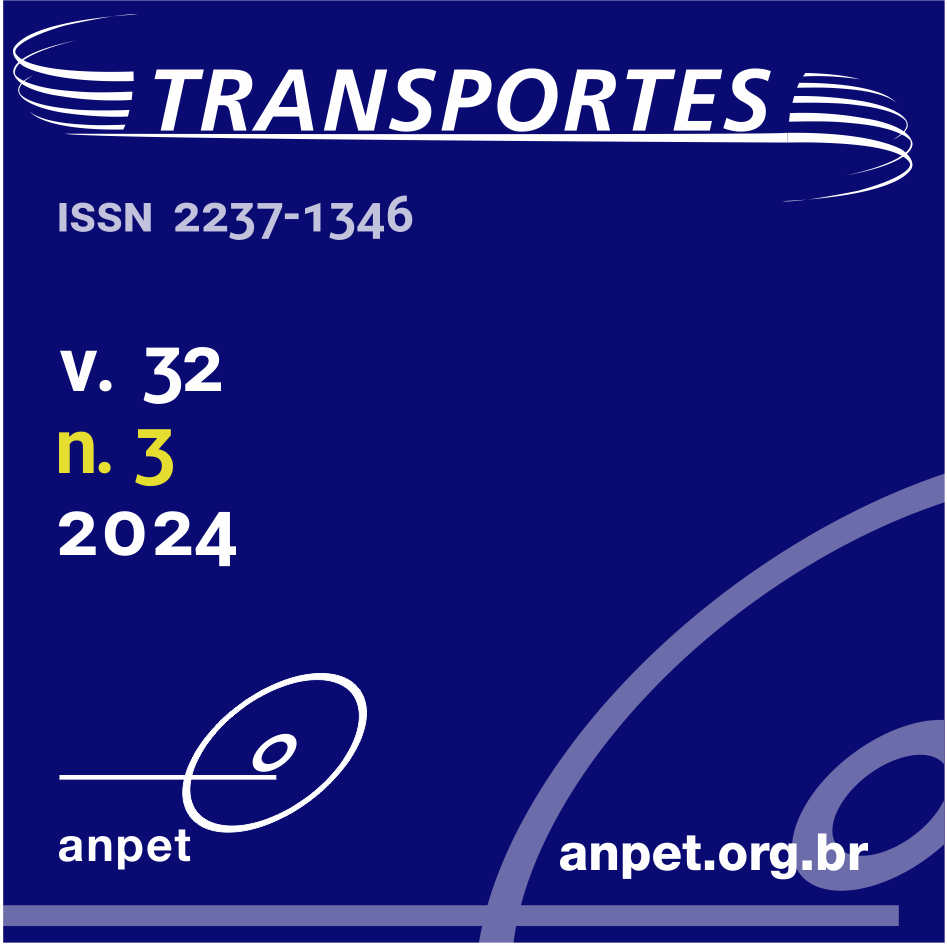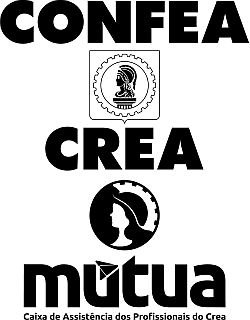Desenvolvimento de uma abordagem espacial multicritério para determinar a localização de espaços de carregamento/descarregamento em centros urbanos
DOI:
https://doi.org/10.58922/transportes.v32i3.2970Palavras-chave:
Logística urbana. Carga urbana. Localização de facilidades. MACBETH. Sistemas de Informações GeográficasResumo
Este artigo apresenta uma nova abordagem que combina programação matemática, métodos de multicritério de apoio à decisão e sistemas de informações geográficas para determinação do número ótimo de vagas para carga/descarga em centros urbanos. A metodologia proposta foi aplicada em um estudo de caso na cidade de Fortaleza, na região Nordeste do Brasil. O uso do método híbrido para a seleção das melhores vagas aumentou o percentual de cobertura dos clientes em 10%, em comparação com aplicação exclusiva de um modelo de programação matemática. Por outro lado, uma vez que a determinação dos potenciais candidatos a vagas não foi baseada em uma abordagem científica, clientes localizados fora da região central apresentaram baixos níveis de serviço, com distâncias de caminhada superiores a 450 m.
Downloads
Referências
Aiura, N. and E. Taniguchi (2005) Planning on-street loading-unloading spaces considering the behaviour of pickup-delivery vehicles. Journal of the Eastern Asia Society for Transportation Studies, v. 6, p. 2963-2974.
Alho, A.R.; J.D.A. Silva; J.P. de Sousa et al. (2018) Improving mobility by optimizing the number, location and usage of loading/ unloading bays for urban freight vehicles. Transportation Research Part D, Transport and Environment, v. 61, n. Pt A, p. 3-18. DOI: 10.1016/j.trd.2017.05.014. DOI: https://doi.org/10.1016/j.trd.2017.05.014
Anselin, L. (1995) Local indicators of spatial association—LISA. Geographical Analysis, v. 27, n. 2, p. 93-115. DOI: 10.1111/j.1538- 4632.1995.tb00338.x. DOI: https://doi.org/10.1111/j.1538-4632.1995.tb00338.x
Anselin, L. (2005) Exploring spatial data with GeoDaTM: a workbook. In Center for spatially integrated social science. Urbana- Champaign, p. 157.
Bana e Costa, C.A. and J.C. Vansnick. (1999) The MACBETH approach: Basic ideas, software, and an application. In H. Raynaud, D. Bouyssou, M. Pirlot et al. Advances in decision analysis. Dordrecht: Springer Netherlands, p. 131-157. DOI: https://doi.org/10.1007/978-94-017-0647-6_9
Bana e Costa, C.A.; J.M. de Corte and J.C. Vansnick. (2010) Macbeth (measuring attractiveness by a categorical based evaluation technique). In J. J. Cochran Wiley Encyclopedia of Operations Research and Management Science. New Jersey:John Wiley & Sons, p. 1-6. DOI: https://doi.org/10.1002/9780470400531.eorms0970
Bana e Costa, C. A; J. M. Corte and J. C. Vansnick (2012) MACBETH. International Journal of of information technology & decision making, v. 11, n. 2, p. 359-387. DOI: 10.1142/S0219622012400068. DOI: https://doi.org/10.1142/S0219622012400068
Bana e Costa, C.A.; L. Angulo Meza and M.D. Oliveira. (2013) O método MACBETH e aplicação no Brasil. Engevista, v. 15, n. 1, p. 3-27. DOI: 10.22409/engevista.v15i1.484. DOI: https://doi.org/10.22409/engevista.v15i1.484
Cbc Solver (2024) Available at: <https://github.com/coin-or/Cbc> (acessed 08/30/2024).
Cepolina, E.M. and A. Farina (2015) A new urban freight distribution scheme and an optimization methodology for reducing its overall cost. European Transport Research Review, v. 7, n. 1, p. 1-14. DOI: 10.1007/s12544-014-0149-x. DOI: https://doi.org/10.1007/s12544-014-0149-x
Chen, T. and C.W. Lin (2017) A fuzzy collaboration system for ubiquitous loading/unloading space recommendation in the logistics industry. Robotics and Computer-integrated Manufacturing, v. 45, p. 86-98. DOI: 10.1016/j.rcim.2016.03.001. DOI: https://doi.org/10.1016/j.rcim.2016.03.001
Crainic, T.G.; N. Ricciardi and G. Storchi (2004) Advanced freight transportation systems for congested urban areas. Transportation Research Part C, Emerging Technologies, v. 12, n. 2, p. 119-37. DOI: 10.1016/j.trc.2004.07.002. DOI: https://doi.org/10.1016/j.trc.2004.07.002
Cruz-Daraviña, P.A. and J.P.B. Suescún (2021) Freight operations in city centers: a land use conflict in urban planning. Land Use Policy, v. 108, p. 105575. DOI: 10.1016/j.landusepol.2021.105575. DOI: https://doi.org/10.1016/j.landusepol.2021.105575
Dablanc, L. (2009) Freight Transport for Development Toolkit: Urban Freight. Washington: The World Bank.
Dijkstra, E.W. (1959) A note on two problems in connection with graphs. Numerische Mathematik, v. 1, n. 1, p. 269-71. DOI: 10.1007/BF01386390. DOI: https://doi.org/10.1007/BF01386390
GeoDa (2024) Available at: <https://geodacenter.github.io/download.html> (acessed 08/30/2024).
Imane, M. and J. Fouad (2019) Proposal methodology of planning and location of loading/unloading spaces for urban freight vehicle: a case study. Advance Science Technology Engineer System Journal, v. 4, n. 5, p. 273-280. DOI 10.25046/aj040534. DOI: https://doi.org/10.25046/aj040534
Ishizaka, A. and P. Nemery (2013) Multi-Criteria Decision Analysis: Methods and Software. Hoboken: John Wiley & Sons. DOI: 10.1002/9781118644898. DOI: https://doi.org/10.1002/9781118644898
JuMP (2024) Available at: <https://www.juliaopt.org/JuMP.jl/stable/> (acessed 08/30/2024).
Lubin, M. and I. Dunning (2015) Computing in operations research using Julia. INFORMS Journal on Computing, v. 27, n. 2, p. 238- 248. DOI: 10.1287/ijoc.2014.0623. DOI: https://doi.org/10.1287/ijoc.2014.0623
Mardle, S.; S. Pascoe and I. Herrero (2004) Management objective importance in fisheries: an evaluation using the analytic hierarchy process (AHP). Environmental Management, v. 33, n. 1, p. 1-11. DOI: 10.1007/s00267-003-3070-y. PMid:14994158. DOI: https://doi.org/10.1007/s00267-003-3070-y
Neghabadi, P.; K. Evrard Samuel and M.L. Espinouse (2019) Systematic literature review on city logistics: overview, classification and analysis. International Journal of Production Research, v. 57, n. 3, p. 865-887. DOI: 10.1080/00207543.2018.1489153. DOI: https://doi.org/10.1080/00207543.2018.1489153
Oliveira, L.K. (2014) Diagnosis of loading and unloading spaces for urban freight distribution: a case study in Belo Horizonte. Journal of Transport Literature, v. 8, n. 1, p. 178-209. DOI: 10.1590/S2238-10312014000100009. DOI: https://doi.org/10.1590/S2238-10312014000100009
Prata, B.; L. Oliveira and T. Holanda (2018) Locating on-street loading and unloading spaces by means of mixed integer programming. Transportes, v. 26, n. 1, p. 16-30. DOI: 10.14295/transportes.v26i1.1051. DOI: https://doi.org/10.14295/transportes.v26i1.1051
Roca-Riu, M.; E. Fernández and M. Estrada (2015) Parking slot assignment for urban distribution: models and formulations. Omega, v. 57, p. 157-175. DOI: 10.1016/j.omega.2015.04.010. DOI: https://doi.org/10.1016/j.omega.2015.04.010
Roca-Riu, M.; J. Cao; I. Dakic et al. (2017) Designing dynamic delivery parking spots in urban areas to reduce traffic disruptions, Journal of Advanced Transportation, v. 2017, n. 1, p. 6296720. DOI: 10.1155/2017/6296720. DOI: https://doi.org/10.1155/2017/6296720
Santos Junior, J.L. and L.K. Oliveira (2020) Analysis of the level of service of unloading zones using diversity measures in a multiplex network. Sustainability (Basel), v. 12, n. 10, p. 4330. DOI: 10.3390/su12104330. DOI: https://doi.org/10.3390/su12104330
Shahparvari, S.; A. Nasirian; A. Mohammadi et al. (2020) A GIS-LP integrated approach for the logistics hub location problem. Computers & Industrial Engineering, v. 146, p. 106488. DOI: 10.1016/j.cie.2020.106488. DOI: https://doi.org/10.1016/j.cie.2020.106488
Silva, K.; A. Labegalini; R. da Silva Lima et al. (2024) Improving freight parking needs in Brazilian cities with city logistics initiatives. Case Studies on Transport Policy, v. 16, p. 101184. DOI: 10.1016/j.cstp.2024.101184. DOI: https://doi.org/10.1016/j.cstp.2024.101184
Taniguchi, E. and D. Tamagawa (2005) Evaluating city logistics measures considering the behavior of several stakeholders. Journal of the Eastern Asia Society for Transportation Studies, v. 6, p. 3062-3076.
Downloads
Publicado
Como Citar
Edição
Seção
Licença
Copyright (c) 2024 Arielle Elias Arantes, Bruno Athayde Prata

Este trabalho está licenciado sob uma licença Creative Commons Attribution 4.0 International License.
Ao submeter um manuscrito para publicação neste periódico, todos os seus autores concordam, antecipada e irrestritamente, com os seguintes termos:
- Os autores mantém os direitos autorais e concedem à Transportes o direito de primeira publicação do manuscrito, sem nenhum ônus financeiro, e abrem mão de qualquer outra remuneração pela sua publicação pela ANPET.
- Ao ser publicado pela Transportes, o manuscrito fica automaticamente licenciado sob a Licença Creative Commons CC BY 4.0. Esta licença permite o seu compartilhamento com reconhecimento da autoria e da publicação inicial neste periódico.
- Os autores têm autorização para assumir contratos adicionais separadamente, para distribuição não exclusiva da versão do trabalho publicada neste periódico (por ex.: publicar em repositório institucional ou como capítulo de livro), com reconhecimento da publicação inicial na Transportes, desde que tal contrato não implique num endosso do conteúdo do manuscrito ou do novo veículo pela ANPET.
- Os autores têm permissão e são estimulados a publicar e distribuir seu manuscrito online (por ex.: em repositórios institucionais ou na sua página pessoal) depois de concluído o processo editorial. Como a Transportes é de acesso livre, os autores são estimulados a usar links para o DOI do artigo nesses casos.
- Os autores garantem que obtiveram todas as permissões necessárias dos empregadores para a publicação e o licenciamento CC BY 4.0 do manuscrito, especialmente se o empregador possuir alguma reivindicação sobre os direitos autorais do manuscrito. Os autores assumem total responsabilidade por questões de direitos autorais relacionadas ao empregador, isentando a ANPET e a Transportes de qualquer responsabilidade relacionada.
- Os autores assumem toda responsabilidade sobre o conteúdo do manuscrito, incluindo as devidas e necessárias autorizações para divulgação de dados coletados e resultados obtidos, isentando a ANPET e a Transportes de toda e qualquer responsabilidade neste sentido.
Última atualização: 27/11/2025











